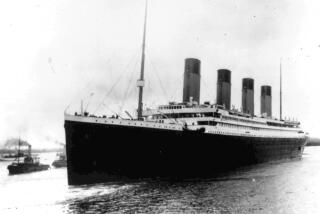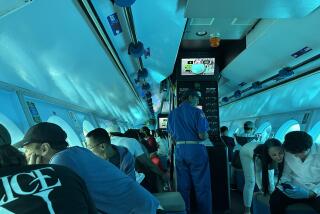Dive! Dive! Idea hatched for sunken U-boat park : The rubber-coated German sub lies in the Potomac. History buffs could come calling in scuba gear.
WASHINGTON â Sheathed in a layer of black rubber to avoid sonar detection, the German World War II U-boat known as the Black Panther served as a model of hit-and-run efficiency, always able to evade Allied counterstrikes thanks to clever German engineering.
That same U-boat now sits dead on the floor of the Potomac River near the coast of Maryland, a victim of U.S. experimentation and study that scuttled the submarine in 1949.
Yet efforts to bring life to the sunken U-1105 are under way as Maryland state officials work with the Navy to develop the countryâs first underwater diving park featuring a sunken WWII vessel.
Donât let the word park fool you. The actual 85-foot dive will be restricted to experienced divers because of the swift currents and low visibility in the Potomac River, said Maryland Historical Trust archeologist Richard Hughes, who is responsible for the parkâs development.
Divers will not be allowed inside the vessel out of concerns for their safety and preservation of the vessel.
âOur job is to protect the Navy heritage,â said Dr. William S. Dudley, senior historian at the Naval Historical Center. âWe really are dealing here with elements of the past.â The U-boat is the property of the federal government.
To appease history buffs who are not divers, a small visitors center probably will be created at a nearby lighthouse, featuring exhibits, historical information, artifacts, photos and diver-made videos of the submarine, Hughes said.
Launched on April 20, 1944, the Black Panther was one of only 10 U-boats coated with four millimeters of synthetic rubber designed to absorb sonar instead of reflecting it back to Allied ships.
The U-1105 patrolled the west coast of Ireland on its only war patrol in April, 1945, engaging enemy destroyers several times in attacks that left one ship badly damaged.
To avoid detection, the U-boat descended to the ocean floor. Allied vessels engaged in a furious search, setting hundreds of depth charges, but the submarine survived.
At the warâs end a month later, the U-boat surrendered to British forces and was eventually turned over to the United States for study. The vessel was scuttled as part of a Navy explosives research test.
To create the park, the trust is seeking $100,000 from a Defense Department fund for preserving historical sites. A number of states already have underwater parks featuring shipwrecks caused by war or accidents. The trust is examining those parks as possible models for the U-boat park.
The dive probably would begin with a trip to the location, marked by a buoy, where divers would be able to follow a single line 85 feet down in muddy water to the sunken vessel, Hughes said.
Once there, divers would see the 50-year-old submarineâs conning tower, still in good condition and the only portion of the U-boat not extensively covered in silt.
Sections of the submarine most likely will be marked off for easy identification, and there is a possibility of installing a surveillance system to protect the vessel from vandals and collectors.
If it werenât for a resourceful Virginia computer technician, the subâs location would remain a mystery.
Fredericksburg resident Uwe Lovas, who said he became interested in shipwrecks as a child, discovered the sunken sub after stumbling upon a Navy error in records of the vesselâs location. Lovas happened upon the mistake in early 1985 while searching for a possible shipwreck that he and two other divers could explore.
Lovas wondered why the Black Panther would have been sunk in waters several hundred miles off the coast of Virginia, where the U.S. Naval Ordinance Disposal Unit and School recorded it.
To Lovasâ excitement, he determined that the report had transposed the longitude figure, from 76 degrees to 67 degrees. The U-boat, he found, was actually just 70 miles from his home.
Lovas, his brother, Ron, and a friend, Alan Russell, searched in the area three times before being able to tie a line onto the wreck and explore it.
âMost shipwrecks decay rapidly, but this has not suffered that kind of decay,â Lovas said, noting that the fresh waters of the Potomac have been gentler than the seawater enveloping most wrecks.
The divers kept quiet about the discovery for five years before inviting U-boat historian Henry Keatts and a photographer to explore it with them. Keatts then documented the find in a diving magazine.
That article subsequently found its way to Maryland state officials, who began working with the Navy to establish the park.
No date has been set for the parkâs opening, although Hughes said it could occur sometime in the next 18 months.
More to Read
Sign up for Essential California
The most important California stories and recommendations in your inbox every morning.
You may occasionally receive promotional content from the Los Angeles Times.










